 The dragonfly shouldn’t hover like this. It wobbles, then steadies itself, seemingly suspended in the air. The bamboo toy that appeared on the bedside table is another of Capella Taipei’s daily gestures that quietly remind you where you are. Like the dragonfly, this is what the best hotels do: make impossible things feel normal.
The dragonfly shouldn’t hover like this. It wobbles, then steadies itself, seemingly suspended in the air. The bamboo toy that appeared on the bedside table is another of Capella Taipei’s daily gestures that quietly remind you where you are. Like the dragonfly, this is what the best hotels do: make impossible things feel normal.
Dragonflies dart through Mingsheng Park at dawn. Songshan District spreads around it with tree-lined streets where, in some places, branches reach tenderly across to join arms. The proximity to Songshan Airport keeps buildings refreshingly low-rise, creating space for boutiques to breathe.
There’s a bookshop curated like a museum, a cookie shop masquerading as a speakeasy, a pineapple cake store that resembles a kindergarten, and Front Door Gallery is hosting an existential art show featuring a rabbit that can’t stop crying.

Expressions That Create Capella Taipei’s Identity
Dragonflies are mesmerizing creatures. Each of their four wings moves independently while propelling the insect forward. Capella’s dining venues operate with similar grace – four distinct expressions creating the hotel’s identity.
There’s the refined omakase restaurant Mizue, Rong Ju with its reimagined Cantonese flavors, the fire-cooking restaurant Ember, and at the heart of it all, the chameleonic Plume that draws guests throughout the day. (The casual patisserie Plume Atelier by the entrance makes five; six when The Glasshouse opens.)
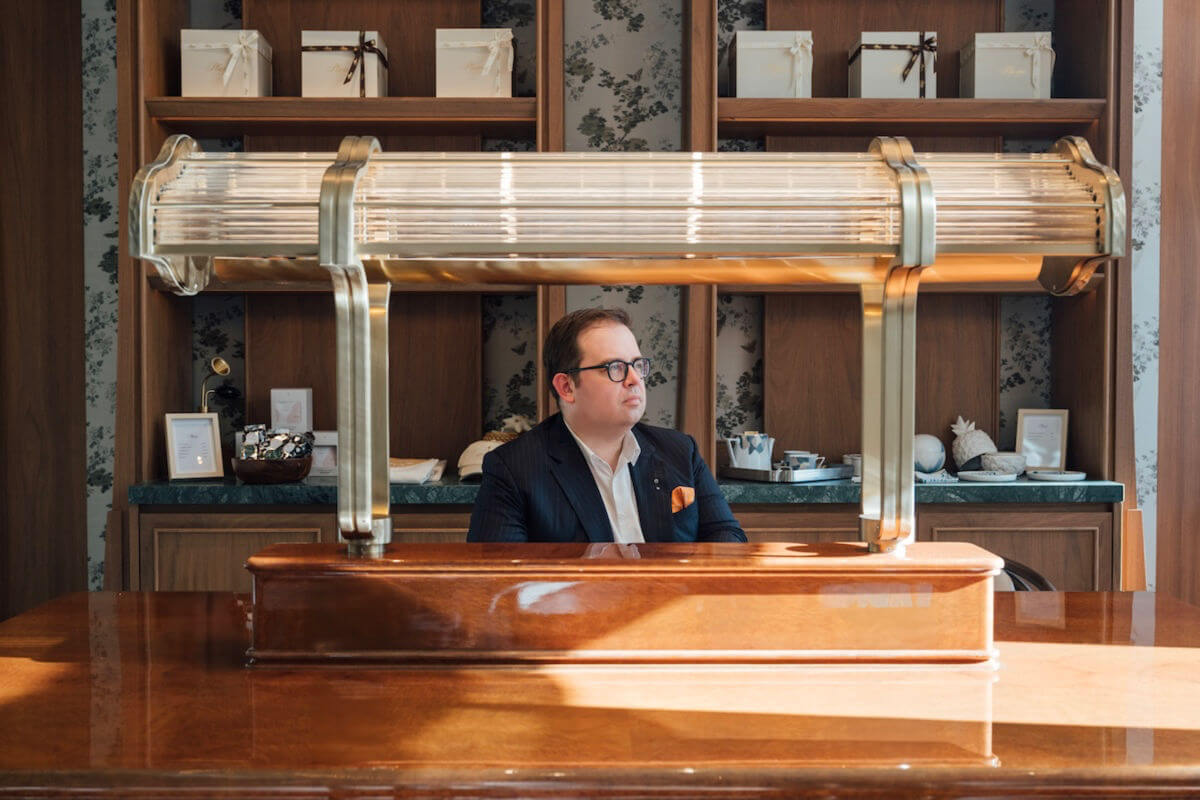
Three Concepts At The Glasshouse
The Glasshouse is almost ready. This two-story glass structure – with another floor below street level – hangs mischievously in front of the KGI Financial Building like an errant teenager smoking behind the bike sheds.
Each floor houses a different concept: a subterranean music room, an all-day casual drinking and dining space, and a whisky room upstairs.
Inside, Angus Winchester, former Global Ambassador for Tanqueray Gin and now Director of Bars for Capella Taipei, adds final touches – recruiting staff, perfecting effortless hospitality, quality-testing Martinis pre-batched in different ratios from 50:50 to 6:1 and chilled to sub-zero temperatures. A cooler full of pre-made ice waits as impatiently as Angus for the first guests. There have been a few early visitors – some rappers shot a music video here, likely a precursor to the raucous times ahead in Playback, the basement venue.

Introducing The “Modern Mansion” Capella Taipei
Inside Capella Taipei’s main doors is an atrium that feels like its shaped like a compass – a wayfinder between the wanderlust that brought guests here and the sanctuary within. An open book rests on a map page, casually disrupting the space’s symmetry, as do the generous flower arrangements before Chen-Lin Lee’s large-scale woven artwork and the basin in which it sits.
The corridor to the left leads from foyer into home. André Fu decided Capella Taipei is a “modern mansion,” and Joel Escalona’s sculpture ‘Quiet Dynamics’ by The Rotunda (a spiral staircase connecting the ground floor spaces) perfectly encapsulates this vision. The stack of blocks – piled as if collected and arranged moments before your arrival – ascends with the same ambition as the KGI Financial Building, while their rustic contours echo the warmth that defines Capella Taipei with its 86 rooms filled with that spirit, including eight suites, six with private pool terraces.
Fittingly for a modern mansion, two large bookcases loom behind reception and concierge desks positioned invitingly low like kindly therapists. (“I’m sensing some unresolved feelings about an excursion to Jiufen?” “You seem tense – would you like me to book a private bath in Beitou?” “There’s strain in your relationship – shall I have those bags sent to your room?”) The bookcases recall Capella’s other go-to designer, Bill Bensley, and his oversized loos at Capella Bali or his grand operatic staircase at Capella Hanoi’s entrance.

Murals And Flashes Of Electric Blue Plumage
Plume has the fascination of an aviary, perhaps because the concept honors Taiwan’s national bird, the Blue Magpie. Flashes of the bird’s electric blue plumage appear throughout, including motifs in the floor-to-ceiling mural by French artist Elsa Jeandedieu.
The gregarious creatures hang out in groups, and Plume is full of them too – cross-generational family catch-ups, university friends on overdue reunions, leisurely dating couples – all congregating around tables at unusual hours. (Plume seems busiest off-peak: late afternoon, early evening, and again late at night.)
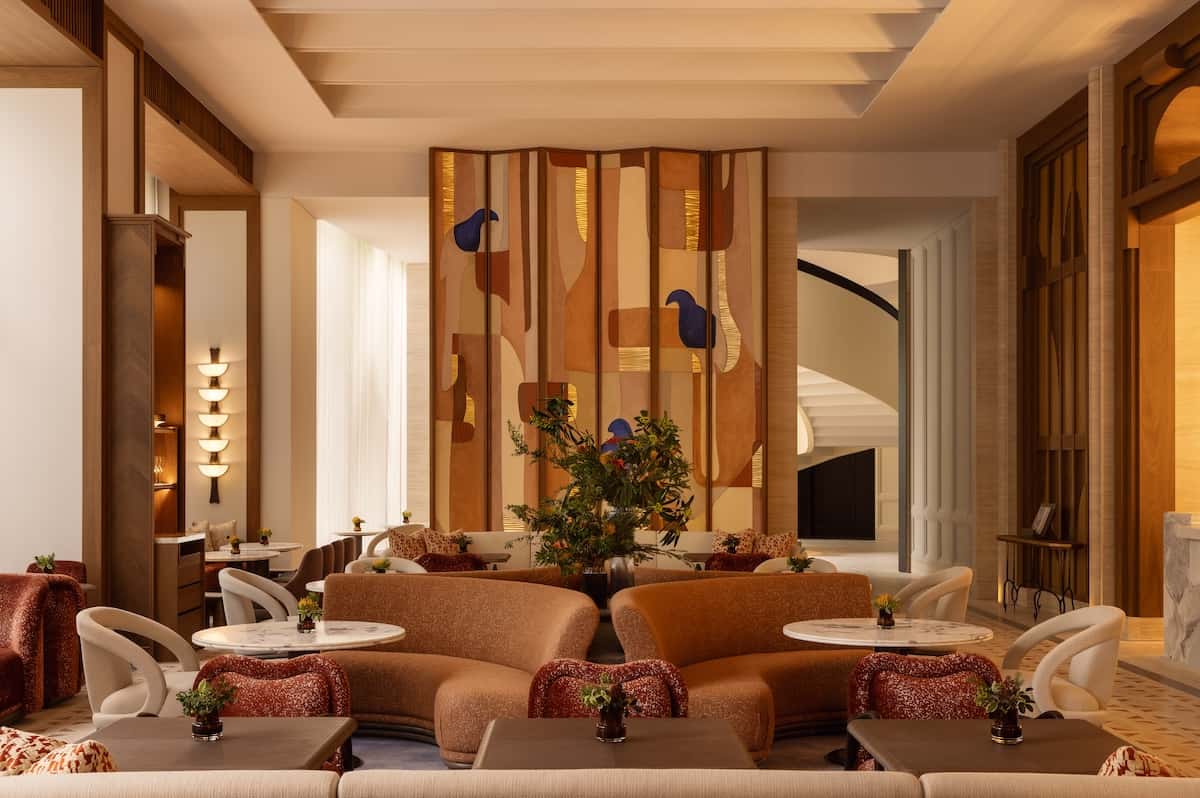
In tribute, the fold-out cocktail menu offers the Blue Magpie its own drink – a milk punch-style cocktail complex and layered with botanical gin, smooth earthy shochu, and Baozhong tea adding floral, grassy notes. It’s beautifully sketched by local artist Ariel Chi alongside seven other indigenous birds: an inquisitive Makada Pheasant, a college-dropout Regulus Goodfellow, and others.
Plume’s all-day menu begins when final breakfast guests drift out at 11am (a dozen oysters and champagne consumed) and runs generously until 11pm – hence the late evening buzz. It pleasingly blends East and West, from maqaw pepper-flavored pork rillettes and lobster rolls to signature braised beef noodles and Plume’s moreish gua bao pork belly buns.

Chatter, Co-Signs And Inspired Spaces
If Plume is an airy aviary filled with chatter, Ember 28 is Capella Taipei’s gentleman’s club games room, its grill topped by a fireplace feature. Grand chandeliers, plush red chairs, and white tablecloths set the scene. Waiters wheel out cuts of meat – the 28-day dry-aged U.S. Flannery Striploin that gives the restaurant its name, U.S. Beef Tenderloin, and reminding guests this steakhouse has a Taiwanese soul, artisanal dry-aged Choho Pork Chop from the island’s south.
Up the spiral staircase, Rong Ju – which earned its MICHELIN recognition just months after opening – takes you around the neighborhood. The name honors two ancient banyan trees in the yard outside, red brick features in the ceiling yearn for home, and the menu features Cantonese flavors and signature teas served unfussily and full of flavor.
Beside it at Mizue, the most in-demand seats occupy a refined, ryokan-inspired space where Chef Hara works quietly while his teacher, the ‘Godfather of Kansai-style Sushi’ Chef Kazuo Morita, watches from a book cover about his restaurant Komatsu Yasuke. He would presumably approve of the champagne-style Mitsubashi sake and ephemeral lobster served two ways – one with prawn-head sauce and joyfully bouncy texture, the other simply with sea salt highlighting natural ocean sweetness.
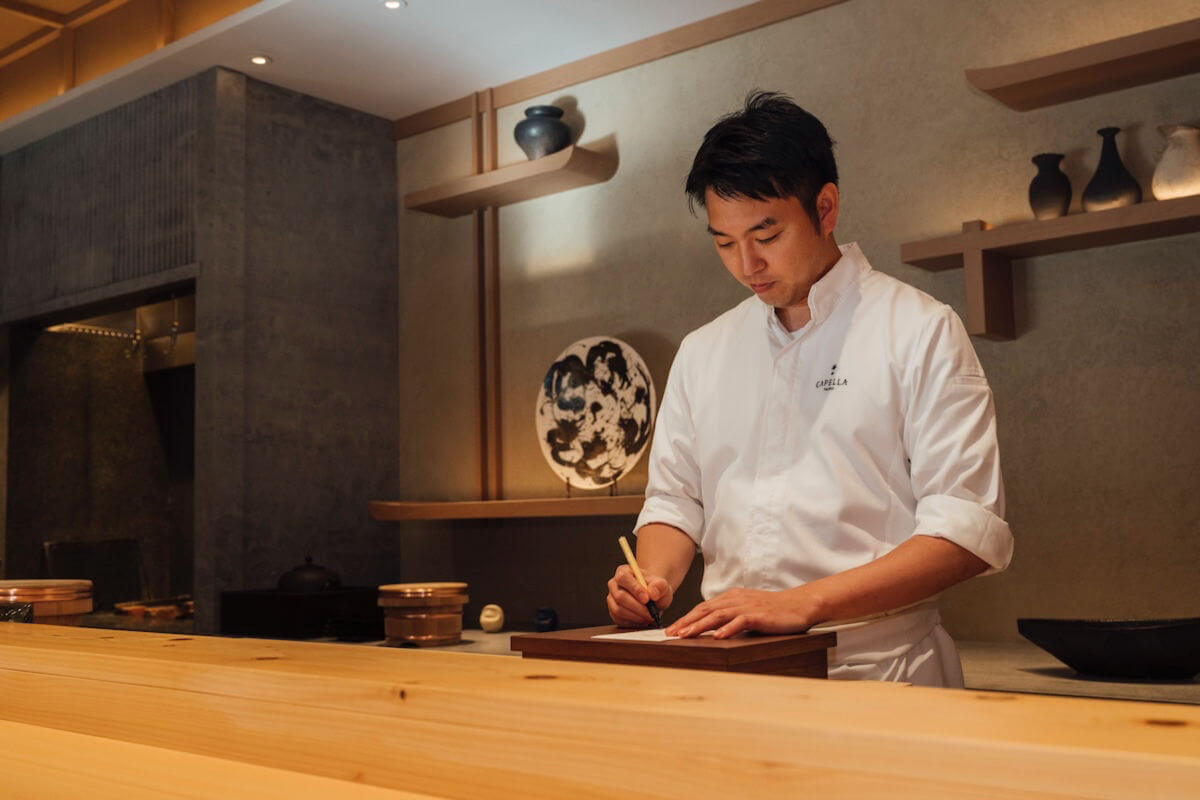
Another Normal Day At The Impossibly Good Capella Taipei
The throng breezing through the ground floor – settling at Plume, Ember 28, and Rong Ju, or dropping by Plume Atelier – feels worlds away from the 14th-floor pool.
The Living Room resembles a movie set from some affluent household drama – a casual concierge desk beside floor-to-ceiling windows where late afternoon sun peeks through abstract screen shapes, backlights woozy lampshades, and caresses soft furnishings like it wants to buy them all but can’t decide.
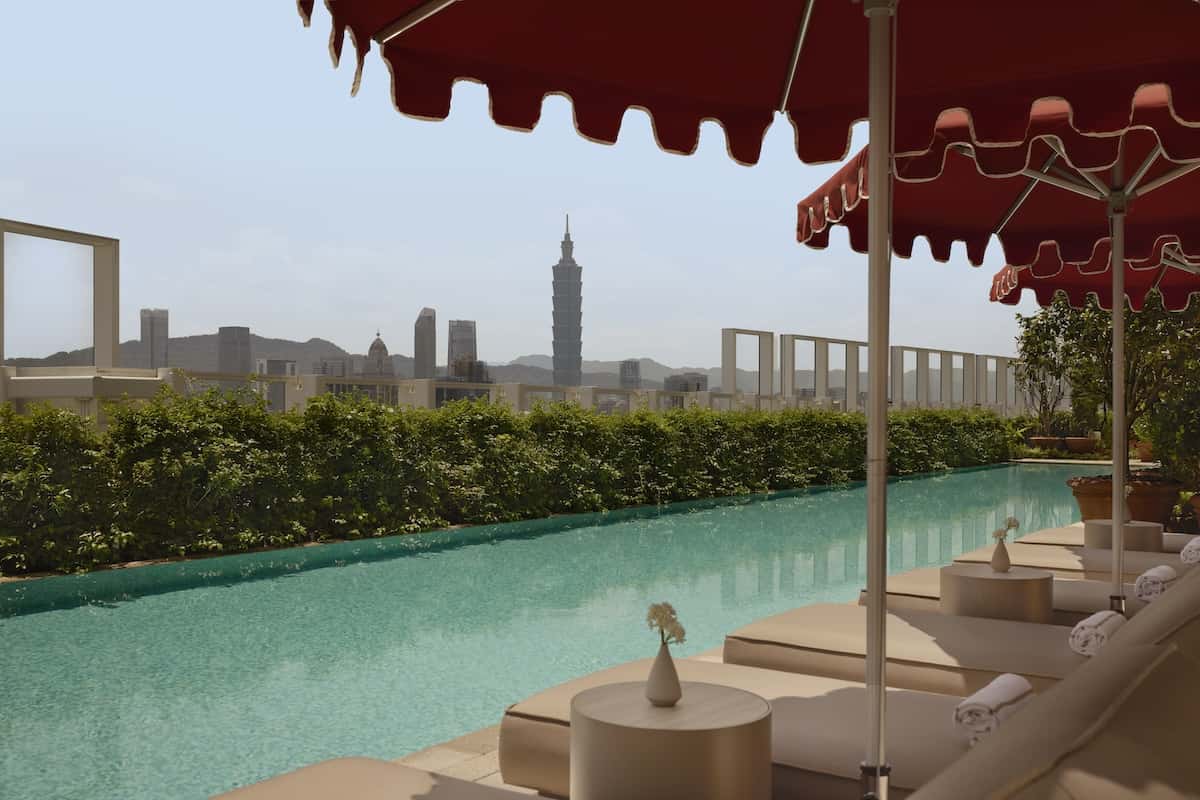
Outside, room floors rise up. As Taipei 101 watches on, the music switches to Walter Wanderley’s breezy bossa nova ‘Nao Sabemos,’ pool umbrellas with turreted fringes flush Chianti red, and a guest floats slowly past on an Oliver James lilo holding a Martini, wobbling slightly like the dragonfly before steadying.
Another normal day at the impossibly good Capella Taipei.


 The dragonfly shouldn’t hover like this. It wobbles, then steadies itself, seemingly suspended in the air. The bamboo toy that appeared on the bedside table is another of Capella Taipei’s daily gestures that quietly remind you where you are. Like the dragonfly, this is what the best hotels do: make impossible things feel normal.
The dragonfly shouldn’t hover like this. It wobbles, then steadies itself, seemingly suspended in the air. The bamboo toy that appeared on the bedside table is another of Capella Taipei’s daily gestures that quietly remind you where you are. Like the dragonfly, this is what the best hotels do: make impossible things feel normal.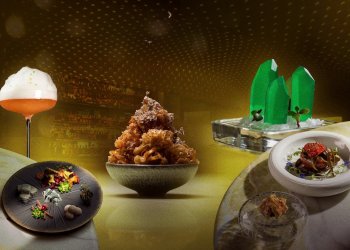






 Wink Hotels' is a new kind of Vietnamese hotel made for the modern traveler and ready to take on the world.
Wink Hotels' is a new kind of Vietnamese hotel made for the modern traveler and ready to take on the world.